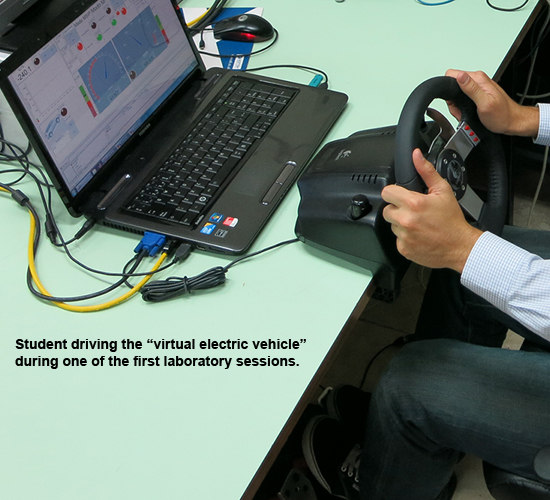Educational Project for the Teaching of Control of Electric Traction Drives
Abstract
:1. Introduction
2. Teaching Objectives and General Approach
- (1)
- A basic level, consisting in a computer simulator based on electrical models of the different components of the drive: energy storage system, power electronics converters, electrical machine and the vehicle itself. A first learning stage includes a series of exercises designed to introduce the students to the system. In a second stage, the students develop their own control strategies based on simulations.
- (2)
- An advanced level, consisting in a reduced scale emulator of the powertrain of an electric vehicle. This emulator is a laboratory workbench that includes a DC voltage source, two power electronics inverters, and two electric motors, one to emulate the inertia and motion resistances of the vehicle and the other the traction machine itself. Using this equipment, and always assisted by a supervisor, the students can test the control strategies developed in the previous stage.
- (1)
- Electric vehicles are a multidisciplinary subject. Therefore, students with different backgrounds (from mechanical to electronic engineering) had to be taken into account.
- (2)
- A smooth learning curve was desirable, which meant carefully planning the progression of the different exercises within the course.
- (3)
- The course had to be as practical as possible. In this sense, it was not enough to show the students a laboratory platform. Higher interaction with the test bench was desired.
3. Technology Overview: Powertrain of a Battery Electric Vehicle

- (1)
- The DC/AC converter works as a voltage source inverter. By means of this converter, both machine flux and machine torque are controlled, either directly or indirectly. The power needed by the motor is instantaneously drawn from the DC link, unless the drive is performing a regenerative braking, in which case power will be delivered to the DC link.
- (2)
- The DC/DC converter works as a conventional buck-boost converter. It dynamically adapts the battery voltage to the DC link voltage while supplying the power needed by the inverter. In traction drives, the DC voltage is usually higher than the battery voltage. The DC voltage may be constant or not, depending on the switching strategy selected for the inverter.
4. Simulation-Based Teaching Platform
4.1. Simulation Model
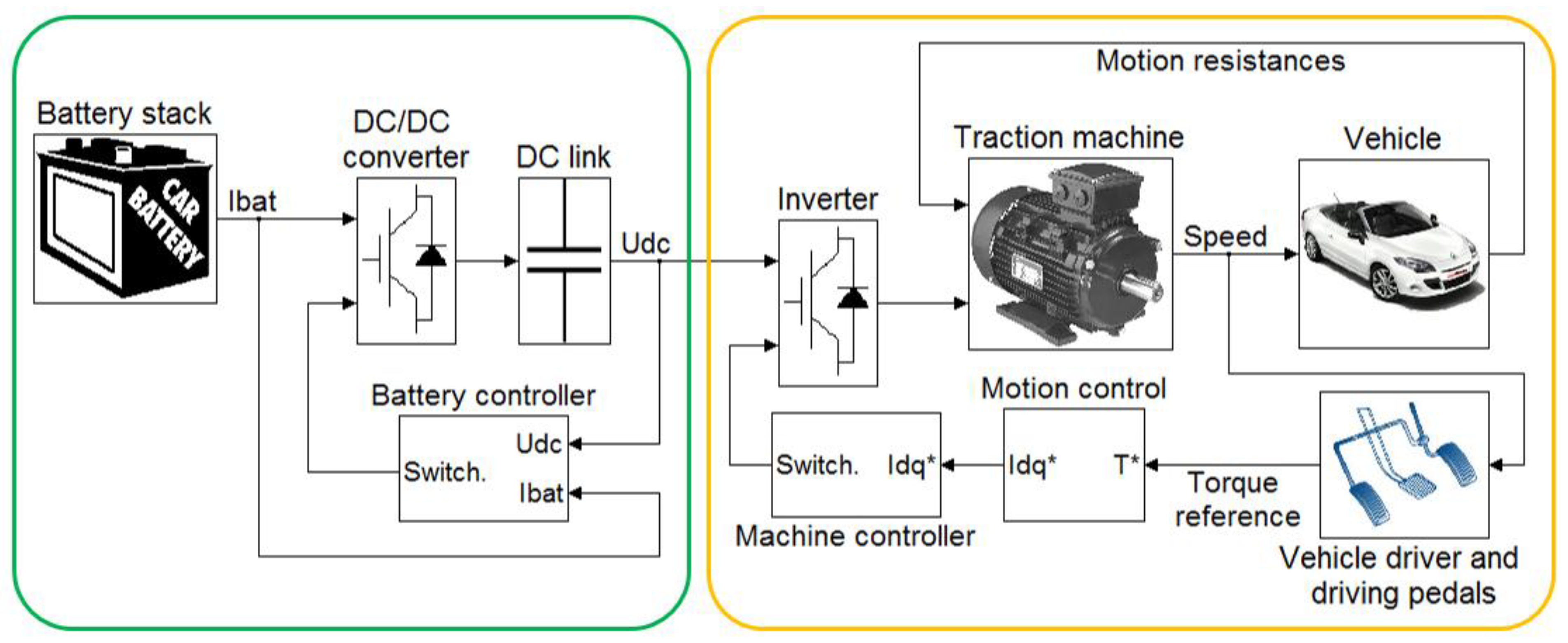
4.1.1. Battery Stack
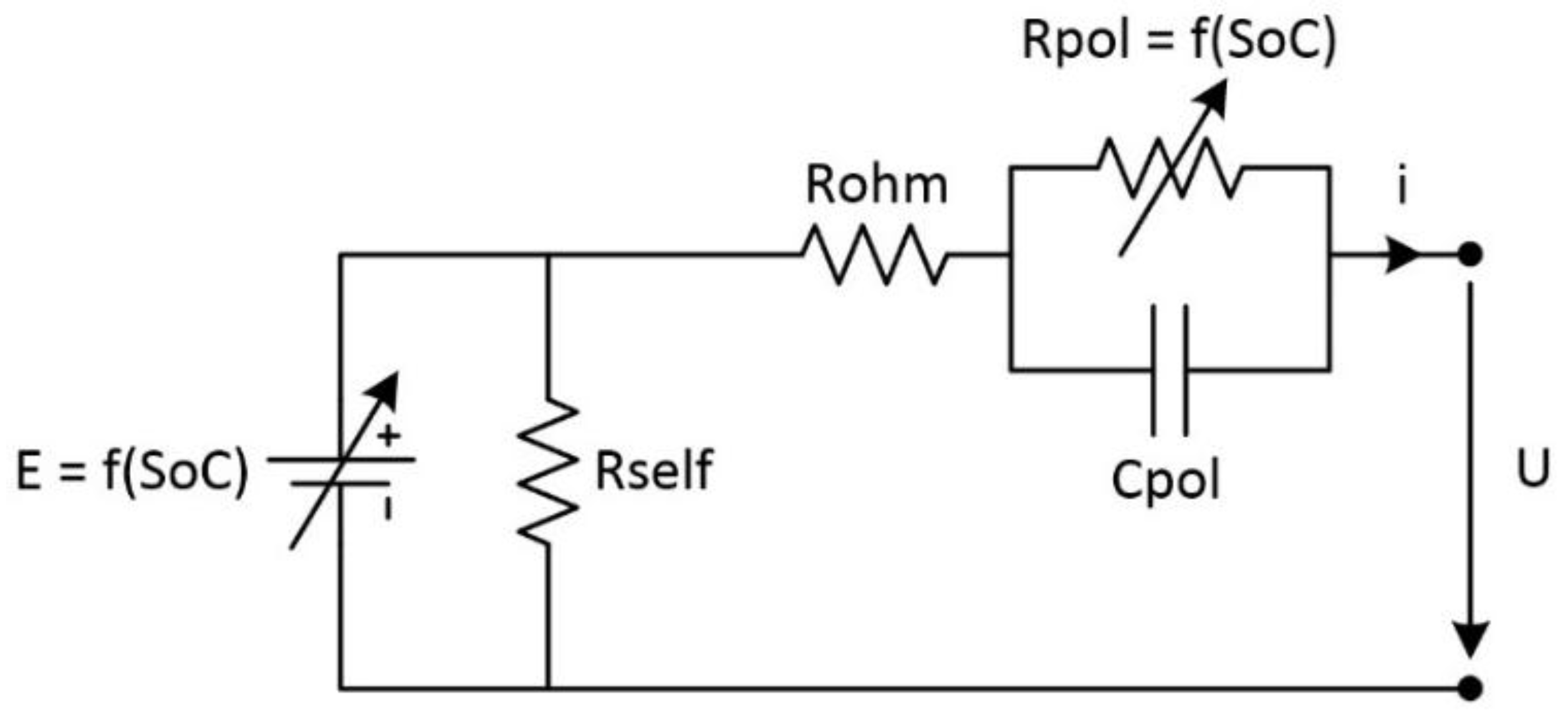
4.1.2. DC/DC Converter and DC Link
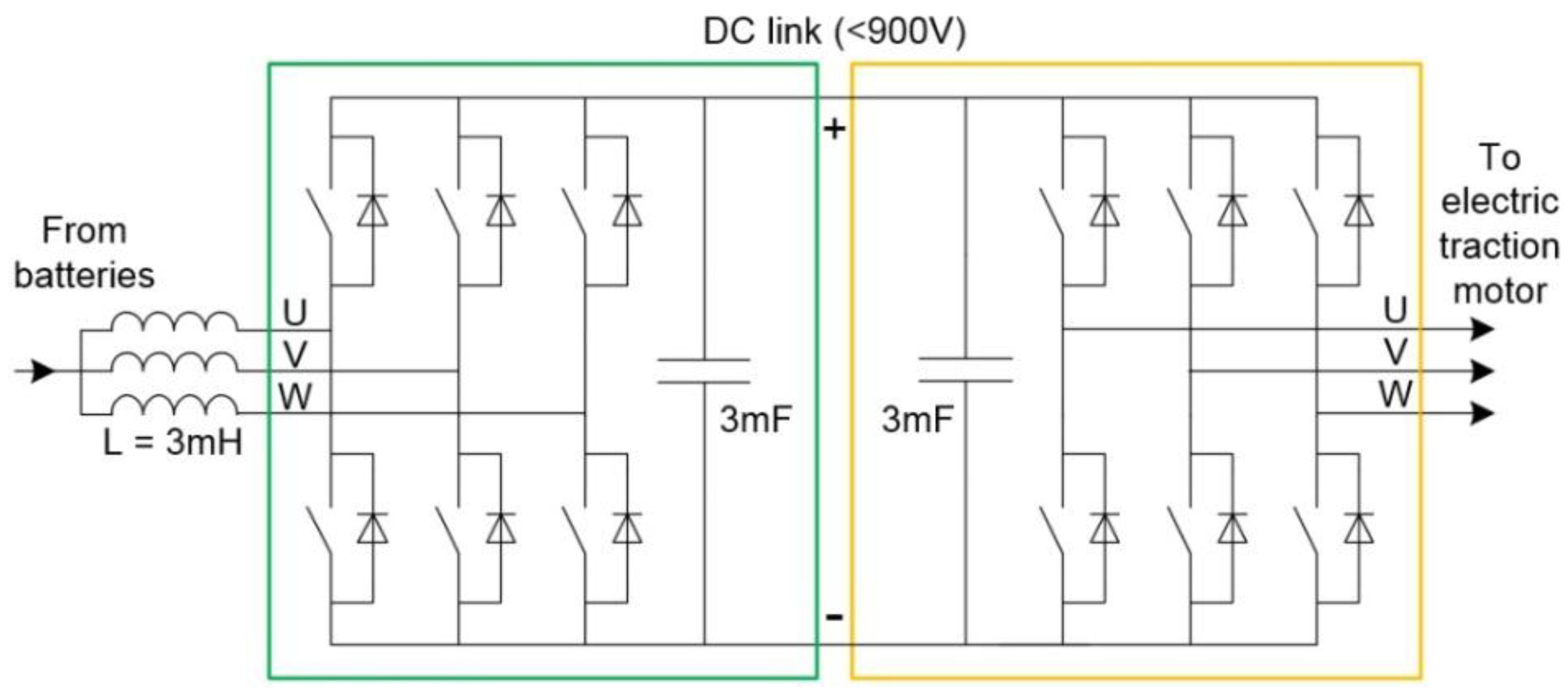
4.1.3. Inverter
4.1.4. Traction Machine
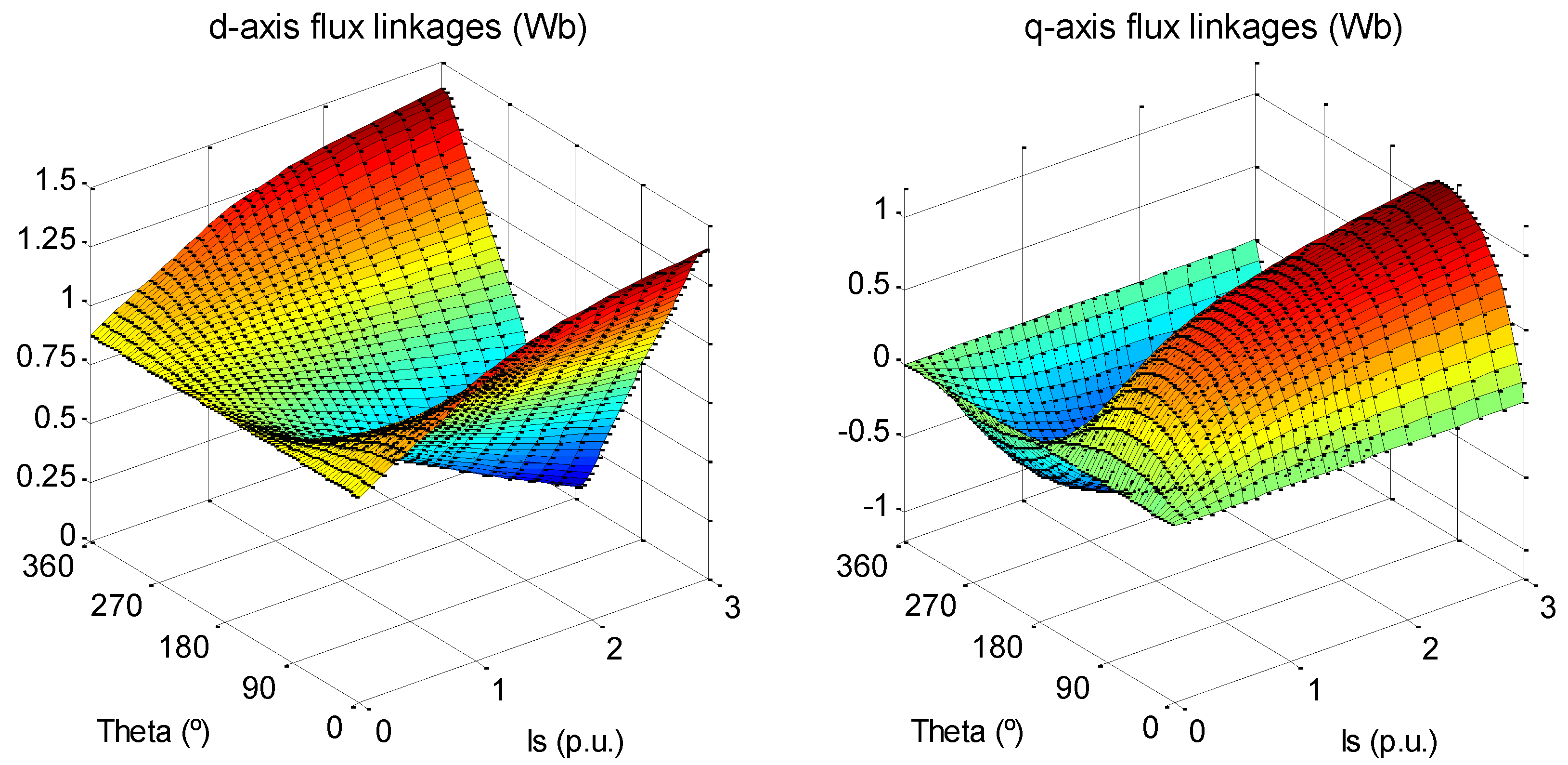
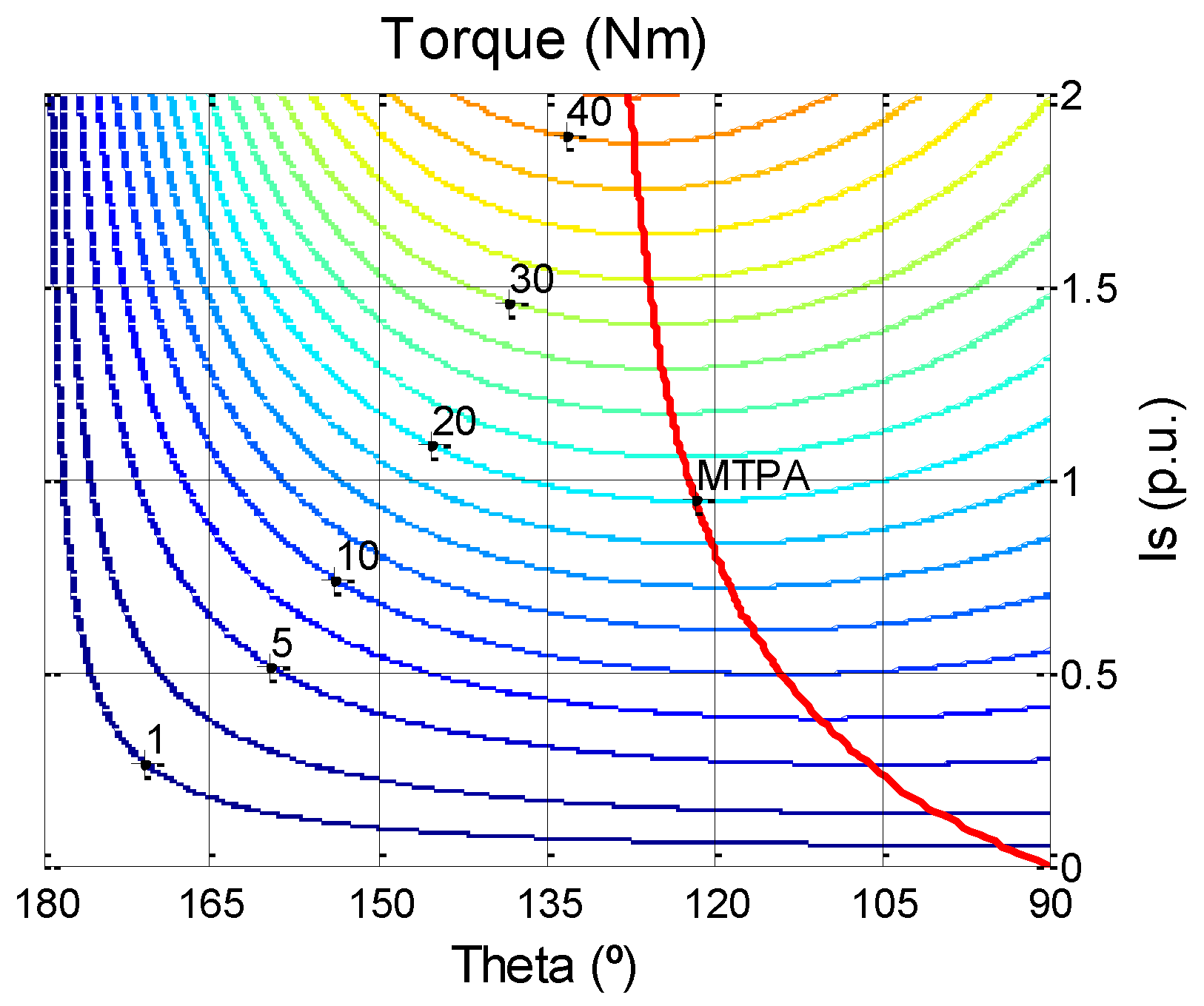
4.1.5. Vehicle and Motion Resistances
4.2. Control Strategies and Switching Techniques
4.3. Teaching Methodology and Case Study
- (1)
- First, a modified version of the simulation model is delivered to the students. This model includes at least one mistake (e.g., incorrect connections) that they must find and correct. This way, the students are compelled to review the model in depth.
- (2)
- Next, the students are asked to identify certain variables (e.g., Iq current) whose evolution they must plot during different driving conditions. With this task, it is assumed that the students understand how the traction drive works.
- (3)
- Finally, a simple task is proposed to the students to make them modify the simulation model for the first time. This task consists in implementing the MTPA trajectory (which is given to them) in the control strategy. Once implemented, the students assess the performance of the drive by comparing both control strategies in terms of torque capability and energy consumption.
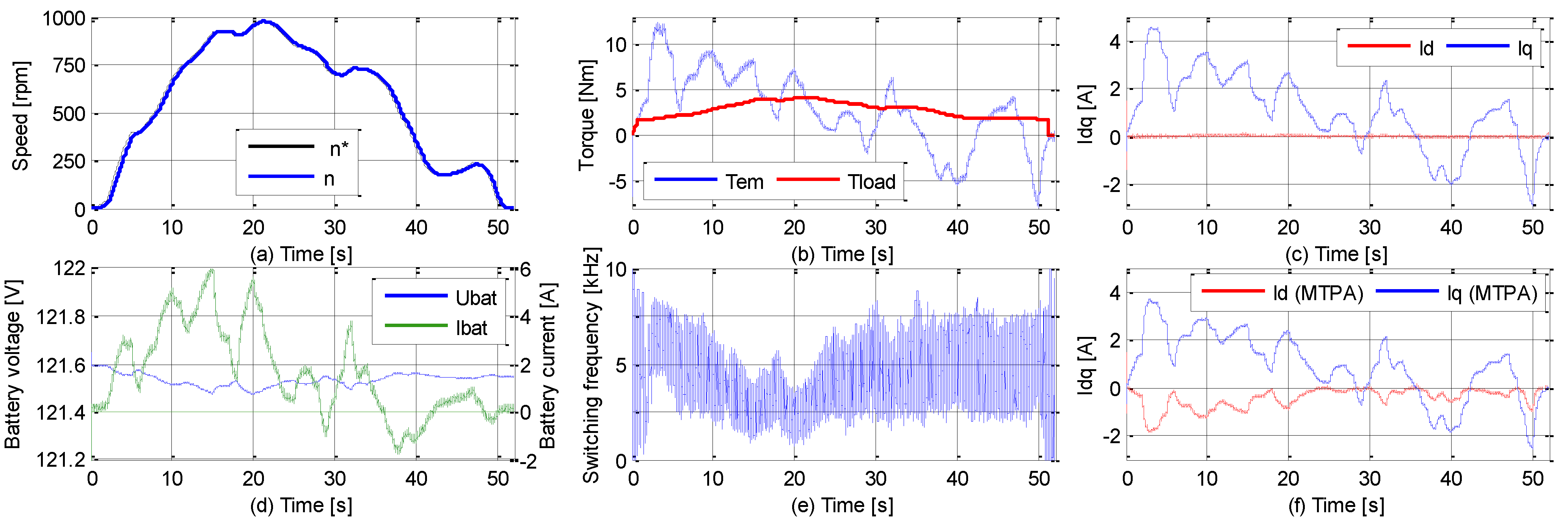
5. Laboratory-Based Teaching Platform
5.1. Test Bench Description and Operation
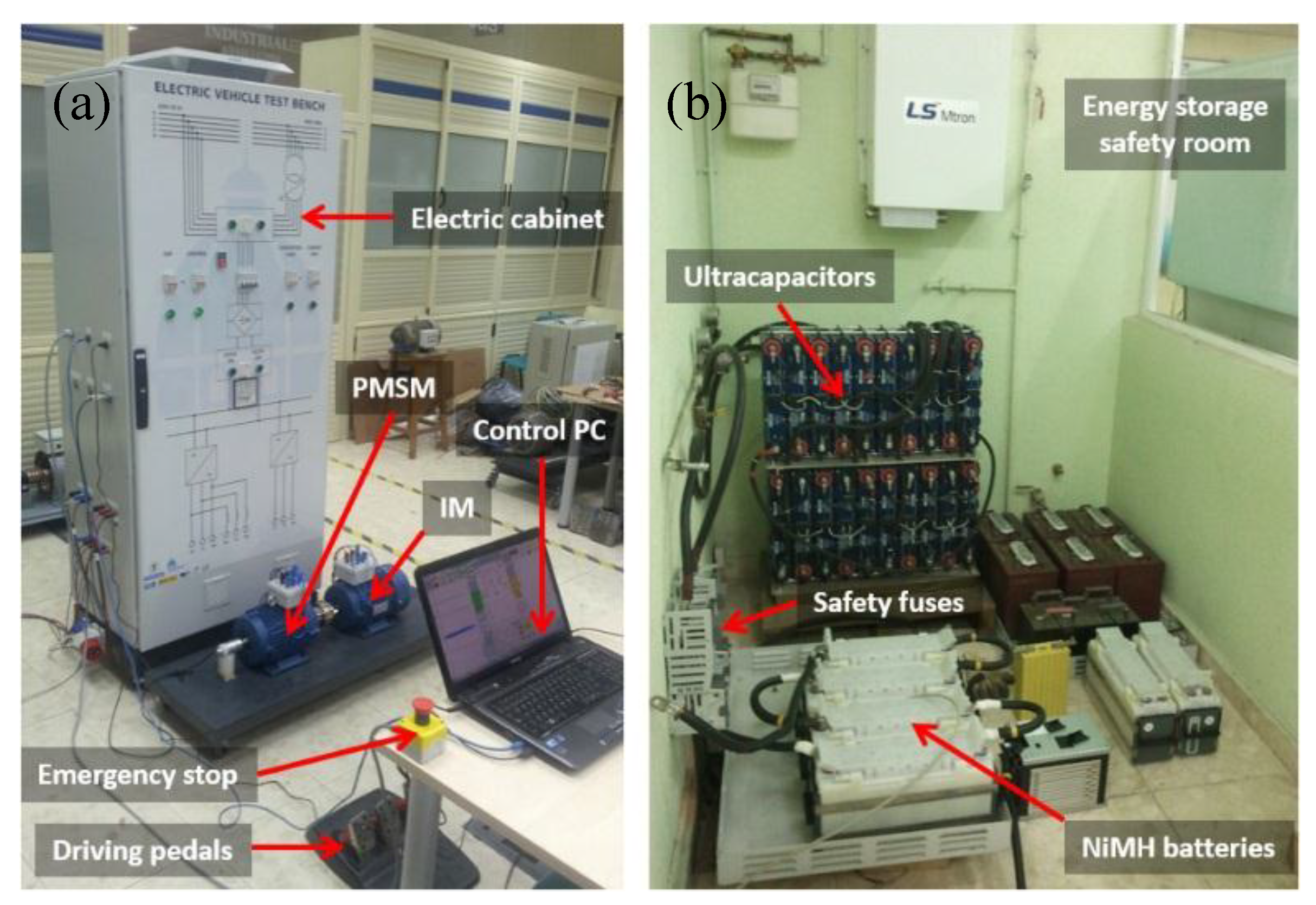
| Traction machine | Load machine (emulator) | ||
| Type | Interior PMSM | Type | Squirrel cage IM |
| Power | 3.3 kW | Power | 2.2 kW |
| Speed | 1500 rpm | Speed | 1420 rpm |
| Pole pairs | 2 | Pole pairs | 2 |
| Voltage | 400 VRMS | Voltage | 400 VRMS |
| Stator current | 4.84 ARMS | Stator current | 4.84 ARMS |
| Inertia | 0.0068 kg·m2 | Inertia | 0.0075 kg·m2 |
| Power converters | Batteries | ||
| Type | IGBT module | Type | NiMH c |
| DC voltage | 380 VDC a | Voltage (total) | 120 V (10 × 12) |
| Current | 60 ARMS | Capacity @C/3 | 100 Ah |
| Switch. freq. | 20 kHz (max) | ||
| Emulated EV | Aerodynamics and rolling | ||
| Type | Fictitious car | Air density ρ | 1.2 kg/m3 |
| Total mass M | 1200 kg | AF | 1.89 m2 |
| Max speed b | 51.3 km/h | CD | 0.37 |
| ERR | 0.25 m | µroll,0 | 0.0135 |
| iGEAR | 17.544 | µroll,S | 0.0055 |
| µGEAR | 95% | ||
5.2. Teaching Methodology and Case Study
- (1)
- First, the students take turns to drive the “virtual electric vehicle”. They must follow a certain urban driving cycle by controlling the drive speed via the accelerator and brake pedals. This urban cycle lasts for one minute and consists in a few accelerations and brakings. In order to increase motivation, each student is given a score that values their performance as drivers once the driving cycle is finished (see example in Figure 9).
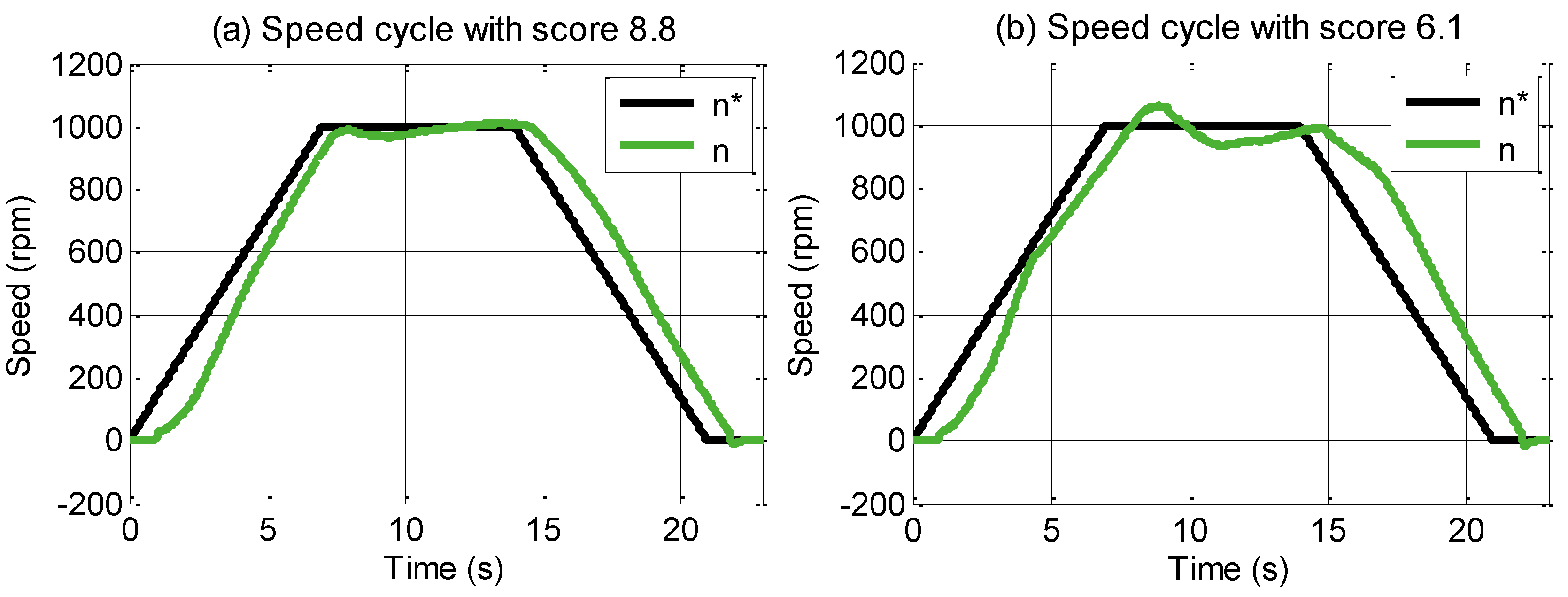
- (2)
- Next, each team implements their chosen control improvement in the test bench assisted by the teacher. Since the control hardware is based on a dSPACE development board (MicroAutoBox II) [32], almost no extra programming needs to be done to implement what the students already developed in Simulink®. The control interface, programmed in dSPACE ControlDesk® Next Generation, is also highly reusable, further shortening the implementation time.
- (3)
- Finally, each team drives the urban cycle of the first exercise again, but with the control modifications implemented in the previous point. Before driving, each team explains to the rest what they have done and what improvement they expect to achieve. This way, all the students learn from what each team has done, regardless of their success.

6. Teaching Results
6.1. Course Assessment
6.2. Students’ Feedback
- (Q1)
- Did this course help you understand electric traction drives and their control?
- (Q2)
- Do you think that you have learned more after the inclusion of this practical session (when compared to a conventional course)?
- (Q3)
- Are you satisfied with the simulation platform?
- (Q4)
- Are you satisfied with the laboratory platform?
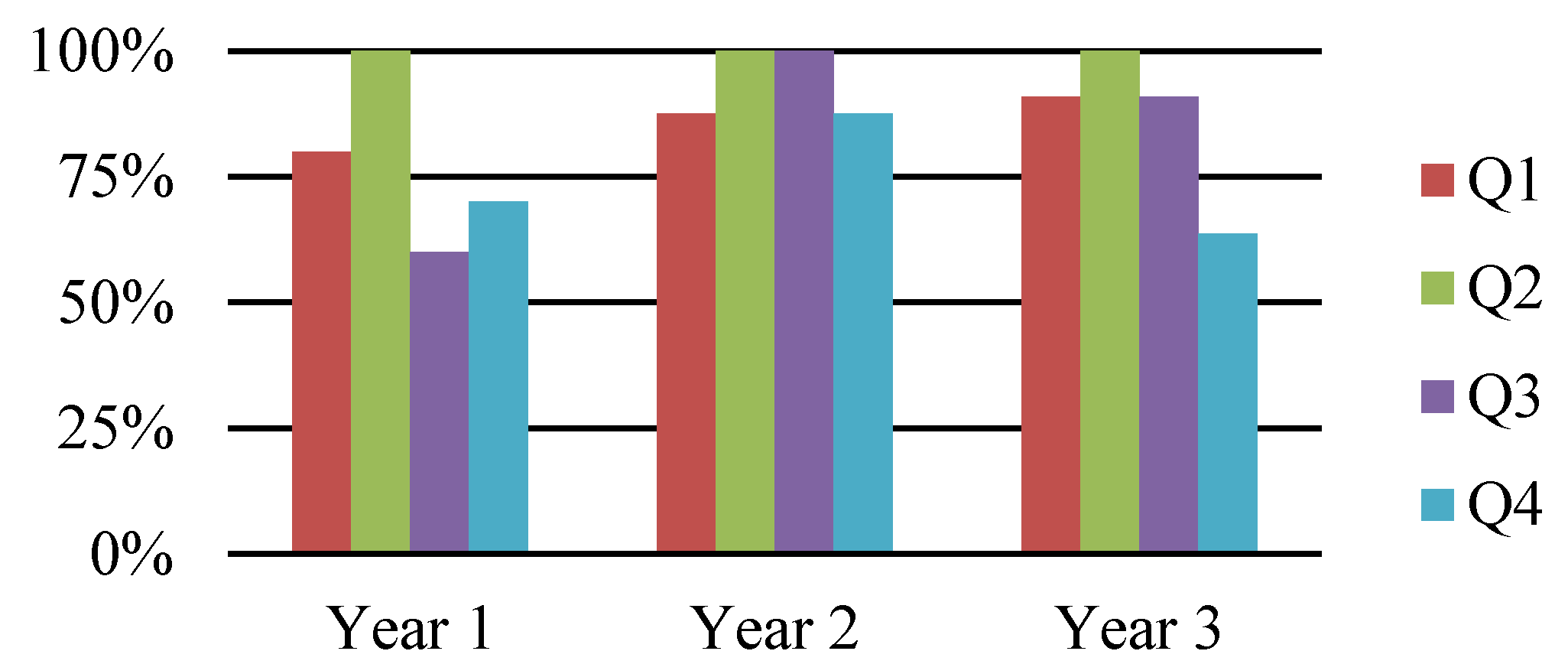
7. Conclusions
Acknowledgments
Author Contributions
Conflicts of Interest
References
- Heffernan, B.; Duke, R.; Zhang, R.; Gaynor, P.; Cusdin, M. A go-cart as an electric vehicle for undergraduate teaching and assessment. In Proceedings of the 20th Australasian Universities Power Engineering Conference (AUPEC 2010), Christchurch, New Zealand, 5–8 December 2010; IEEE: New York, NY, USA, 2010. [Google Scholar]
- Reddy, G.N. An EV-simulator for electric vehicle education. In Proceedings of the International Conference on Engineering Education (ICEED 2009), Kuala Lumpur, Malaysia, 7–8 December 2009; IEEE: New York, NY, USA, 2009. [Google Scholar]
- Prasanth, V.; Bauer, P.; Ildikó, P. Drivetrain of electric car: Development of virtual lab for E-learning. In Proceedings of the IEEE International Workshop on Advanced Motion Control, Sarajevo, Bosnia and Herzegovina, Yugoslavia, 25–27 March 2012; IEEE: New York, NY, USA, 2012. [Google Scholar]
- Schafer, U. Electric vehicles—Educational aspects. In Proceedings of the XXth International Conference on Electrical Machines (ICEM 2012), Marseille, France, 2–5 September 2012; IEEE: New York, NY, USA, 2012. [Google Scholar]
- Kumar, A.; Fernando, S.; Panicker, R.C. Project-based learning in embedded systems education using an FPGA platform. IEEE Trans. Educ. 2013, 56, 407–415. [Google Scholar] [CrossRef]
- Ferrater-Simon, C.; Molas-Balada, L.; Gomis-Bellmunt, O.; Lorenzo-Martinez, N.; Bayo-Puxan, O.; Villafafila-Robles, R. A remote laboratory platform for electrical drive control using programmable logic controllers. IEEE Trans. Educ. 2009, 52, 425–435. [Google Scholar] [CrossRef]
- Oriti, G.; Julian, A.L.; Zulaic, D. Doubly fed induction machine drive hardware laboratory for distance learning education. IEEE Trans. Power Electron. 2014, 29, 440–448. [Google Scholar] [CrossRef]
- Arribas, J.R.; Veganzones, C.; Blazquez, F.; Platero, C.A.; Ramirez, D.; Martinez, S.; Sanchez, J.A.; Herrero Martinez, N. Computer-based simulation and scaled laboratory bench system for the teaching and training of engineers on the control of doubly fed induction wind generators. IEEE Trans. Power Syst. 2011, 26, 1534–1543. [Google Scholar] [CrossRef]
- Bouscayrol, A.; Guillaud, X.; Delarue, P.; Lemaire-Semail, B. Energetic macroscopic representation and inversion-based control illustrated on a wind energy conversion systems using hardware-in-the-loop simulation. IEEE Trans. Ind. Electron. 2009, 56, 4826–4835. [Google Scholar] [CrossRef]
- He, H.-W.; Xiong, R.; Chang, Y.-H. Dynamic modeling and simulation on a hybrid power system for electric vehicle applications. Energies 2010, 3, 1821–1830. [Google Scholar] [CrossRef]
- Chan, C.C.; Bouscayrol, A.; Chen, K. Electric, hybrid, and fuel-cell vehicles: Architectures and modeling. IEEE Trans. Vehicular Technol. 2010, 59, 589–598. [Google Scholar] [CrossRef]
- Mohan, G.; Assadian, F.; Longo, S. An optimization framework for comparative analysis of multiple vehicle powertrains. Energies 2013, 6, 5507–5537. [Google Scholar] [CrossRef]
- MathWorks, MatLab R2014a Documentation Center. Available online: http://www.mathworks.com/help/physmod/sps/index.html (accessed on 31 October 2014).
- Tremblay, O.; Dessaint, L.-A. Experimental validation of a battery dynamic model for EV applications. World Electr. Veh. J. 2009, 3, 1–10. [Google Scholar]
- Chen, M.; Rincón-Mora, G.A. Accurate electrical battery model capable of predicting runtime and I-V performance. IEEE Trans. Energy Convers. 2006, 21, 504–511. [Google Scholar] [CrossRef]
- Semikron, SEMIX71GD12E4s IGBT Modules. Available online: http://www.semikron.com/products/product-classes/igbt-modules/detail/semix71gd12e4s-27890190.html (accessed on 2 January 2015).
- Mohan, N.; Undeland, T.; Robbins, W. Power Electronics: Converters, Applications, and Design, 3rd ed.; Wiley John & Sons, Inc.: Hoboken, NJ, USA, 2003. [Google Scholar]
- Zhang, S.; Yu, X. A unified analytical modeling of the interleaved pulse width modulation (PWM) DC-DC converter and its applications. IEEE Trans. Power Electron. 2013, 28, 5147–5158. [Google Scholar] [CrossRef]
- Kazmierkowski, M.; Franquelo, L.; Rodriguez, J.; Perez, M.; Leon, J. High-performance motor drives. IEEE Ind. Electron. Mag. 2011, 5, 6–26. [Google Scholar] [CrossRef]
- Krishnan, R. Electric Motor Drives: Modeling, Analysis and Control; Prentice Hall: Upper Saddle River, NJ, USA, 2001. [Google Scholar]
- Akagi, H.; Watanabe, E.H.; Aredes, M. Instantaneous Power Theory and Applications to Power Conditioning; Wiley-IEEE Press: Hoboken, NJ, USA, 2007. [Google Scholar]
- Bianchi, N. Electrical Machine Analysis Using Finite Elements; Taylor & Francis: Abingdon, UK, 2005. [Google Scholar]
- Gallegos-Lopez, G.; Hiti, S. Optimum current control in the field-weakened region for permanent magnet AC machines. In Proceedings of the IEEE Industry Applications Conference, New Orleans, LA, USA, 23–27 September 2007; IEEE: New York, NY, USA, 2007. [Google Scholar]
- Schaltz, E. Electrical vehicle design and modeling. In Electric Vehicles—Modelling and Simulations; InTech: Rijeka, Croatia, 2011; Chapter 1; pp. 1–24. [Google Scholar]
- Ehsani, M.; Gao, Y.; Emadi, A. Modern Electric, Hybrid Electric, and Fuel Cell Vehicles: Fundamentals, Theory, and Design, 2nd ed.; CRC Press: New York, NY, USA, 2009. [Google Scholar]
- Xu, Q.; Cui, S.; Song, L.; Zhang, Q. Research on the power management strategy of hybrid electric vehicles based on electric variable transmissions. Energies 2014, 7, 934–960. [Google Scholar] [CrossRef]
- Batchelor, G.K. An Introduction to Fluid Dynamics; Cambridge University Press: Cambridge, UK, 2000. [Google Scholar]
- Pacejka, H.B. Tyre and Vehicle Dynamics; Butterworth-Heinemann: Oxford, UK, 2006. [Google Scholar]
- Arango, E.; Ramos-Paja, C.A.; Calvente, J.; Giral, R.; Serna, S. Asymmetrical interleaved DC/DC switching converters for photovoltaic and fuel cell applications—Part 1: Circuit generation, analysis and design. Energies 2012, 5, 4590–4623. [Google Scholar] [CrossRef]
- Rahman, K.; Khan, M.; Choundhury, M.; Rahman, M. Variable-band hysteresis current controllers for PWM voltage-source inverters. IEEE Trans. Power Electron. 1997, 12, 964–970. [Google Scholar] [CrossRef]
- André, M. The ARTEMIS European driving cycles for measuring car pollutant emissions. Sci. Total Environ. 2004, 334–335, 73–84. [Google Scholar] [CrossRef] [PubMed]
- dSPACE Website. Available online: http://www.dspace.com/en/pub/home/products.cfm (accessed on 31 October 2014).
© 2015 by the authors; licensee MDPI, Basel, Switzerland. This article is an open access article distributed under the terms and conditions of the Creative Commons Attribution license (http://creativecommons.org/licenses/by/4.0/).
Share and Cite
Moreno-Torres, P.; Blanco, M.; Lafoz, M.; Arribas, J.R. Educational Project for the Teaching of Control of Electric Traction Drives. Energies 2015, 8, 921-938. https://doi.org/10.3390/en8020921
Moreno-Torres P, Blanco M, Lafoz M, Arribas JR. Educational Project for the Teaching of Control of Electric Traction Drives. Energies. 2015; 8(2):921-938. https://doi.org/10.3390/en8020921
Chicago/Turabian StyleMoreno-Torres, Pablo, Marcos Blanco, Marcos Lafoz, and Jaime R. Arribas. 2015. "Educational Project for the Teaching of Control of Electric Traction Drives" Energies 8, no. 2: 921-938. https://doi.org/10.3390/en8020921
APA StyleMoreno-Torres, P., Blanco, M., Lafoz, M., & Arribas, J. R. (2015). Educational Project for the Teaching of Control of Electric Traction Drives. Energies, 8(2), 921-938. https://doi.org/10.3390/en8020921






